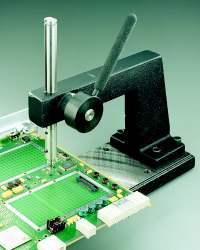No. 5.3
Plated Hole Repair, Inner Layer Connection
OUTLINE
This procedure describes the use of flat set eyelets for the repair of a
through connection that has an inner layer connect. No surface wire is used. The
inner layer reconnect is established by soldering the barrel of an eyelet to the
exposed inner layer and the connection is encapsulated in high strength epoxy.
CAUTION
This is a complex repair procedure that demands the proper tools and materials.
To expect reliable results, repair technicians must have a high level of
expertise. Use this method only when alternative methods are unacceptable.
CAUTION
This procedure requires very accurate control over the location and depth of a
milled hole. It is recommended that a precision drill system be used in
combination with a high power stereo microscope.
TOOLS & MATERIALS
Ball Mills
Caliper
Cleaner
End Mills
Eyelet Press
Eyelets, Various Sizes
Flux, Liquid
Knife
Micro-Drill System
Microscope
Pin Gauges
Plated Hole Repair Kit
Precision Drill System
Setting Form Tool, Various Sizes
Setting Anvil, Various Sizes
Solder Iron
Solder
Wipes
EYELET SELECTION CRITERIA
ID - Inside Diameter
The eyelet inside diameter should be a .075 - .500 mm (.003"-.020")
greater than the component lead diameter.
LUF - Length Under Flange
The length of the eyelet barrel under the flange should be .630 - .890 mm
(.025" - 035") greater than the thickness of the circuit board. This added
length allows for proper protrusion when setting the eyelet.
FD - Flange Diameter
The eyelet flange diameter should be small enough to prevent interference with
adjacent lands or circuits.
OD - Outside Diameter
The clearance hole drilled through the circuit board should allow the eyelet to be
inserted without force but should not exceed .125 mm (.005") greater than
the eyelet outside diameter.
NOTE
Be sure to select an eyelet meeting the proper criteria. An eyelet with an
oversize flange may interfere with adjacent circuits. An eyelet that is too
short will not protrude through the circuit board for proper setting.
PROCEDURE
- Clean the area.
- Select an eyelet using the Eyelet Selection Criteria. Use a pin gauge and
caliper to measure the existing plated hole dimensions.
- Pin the circuit board to the base of the Precision Drill System. (See Figure 1).
- Insert the appropriate ball mill, end mill or drill into the chuck of the
drill press.
- Mill or drill out the hole. The drilled hole should be approximately .030 mm
(0.001") larger than the eyelet O.D. Inspect to ensure no metallic
particles or burrs remain.
- Select the side of the assembly that will have a counterbored hole milled
into it. This side preferably would have no surface connection.
- Select an end mill approximately .050 - .075 mm (.020" - .030")
larger than the eyelet diameter. Insert into the Precision Drill System and mill
down to and expose the inner layer signal or plane. (See Fig. 2).
CAUTION
Great care must be taken to control the depth of the milled hole to prevent
damage to the inner layer signal or plane.
- Clean the area.
- Apply a small amount of flux to the exposed signal or plane and tin with
solder.
- Clean the area.
- Insert the eyelet into the hole from the side opposite the milled hole, then
apply a small amount of flux into the milled hole.
- Solder the eyelet to the exposed inner layer signal or plane by applying
heat from a soldering iron to the barrel of the eyelet. (See Figure 3).
- Completely remove any solder flux residue by spray rinsing with cleaner.
- Use a microscope and inspect the solder fillet from the eyelet to the inner
connection and perform electrical tests as required.
- Mix epoxy as required.
- Fill the milled hole with the epoxy up to, and level with, the surface of
the board. (See Figure 4). The epoxy filler material should be free of voids and
air bubbles.
- Cure the epoxy per Procedure 2.7 Epoxy Mixing and Handling.
- Select the proper setting tools and insert them into the eyelet press. (See
Figure 5).
- Turn the circuit board over and rest the eyelet flange on the lower setting tool.
- Apply firm even pressure to form the eyelet barrel. (See Figure 6).
- Install the component lead and solder, if required.
- Clean the area.
EVALUATION
- Visual examination, dimensional requirement of land diameter and inside
diameter.
- Electrical continuity as required.
|
|
|
Solutions Across the Board
TM
|
|
|
|
Product Class: R
Skill Level: Expert
Conformance Level: Medium
Revision: E
Revision Date: Mar 28, 2001
Repair Service Charge

Damaged Plated Hole with Inner Layer Connection

Figure 1: Precision Drill System shown with circuit board pinned in place.

Figure 2: Mill down to and expose inner layer signal or plane.

Figure 3: Solder the eyelet barrel to the exposed inner layer signal or plane.

Figure 4: Fill the milled hole with the epoxy up to, and level with, the surface
of the board.

Figure 5: Set the eyelet using an Eyelet Press.

Figure 6: Eyelet barrel formed flat to circuit board surface.
|
Tricks of the Trade
A challenging but routine repair procedure completed daily at
Circuit Technology Center. You may want to have this type of repair completed by
experts. Give us a call.
|
|
|








